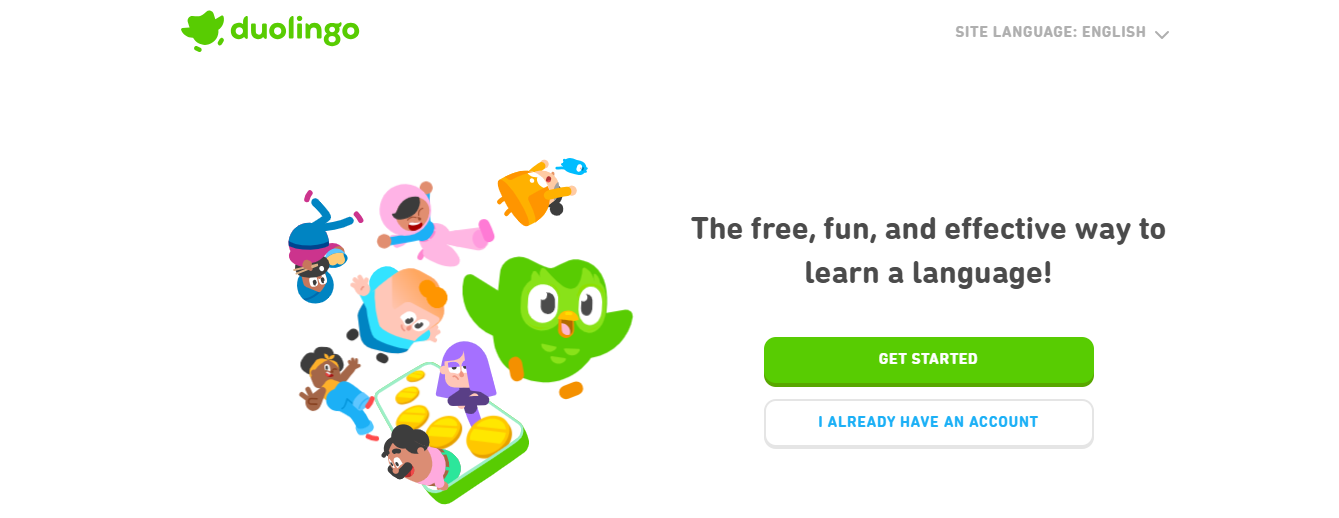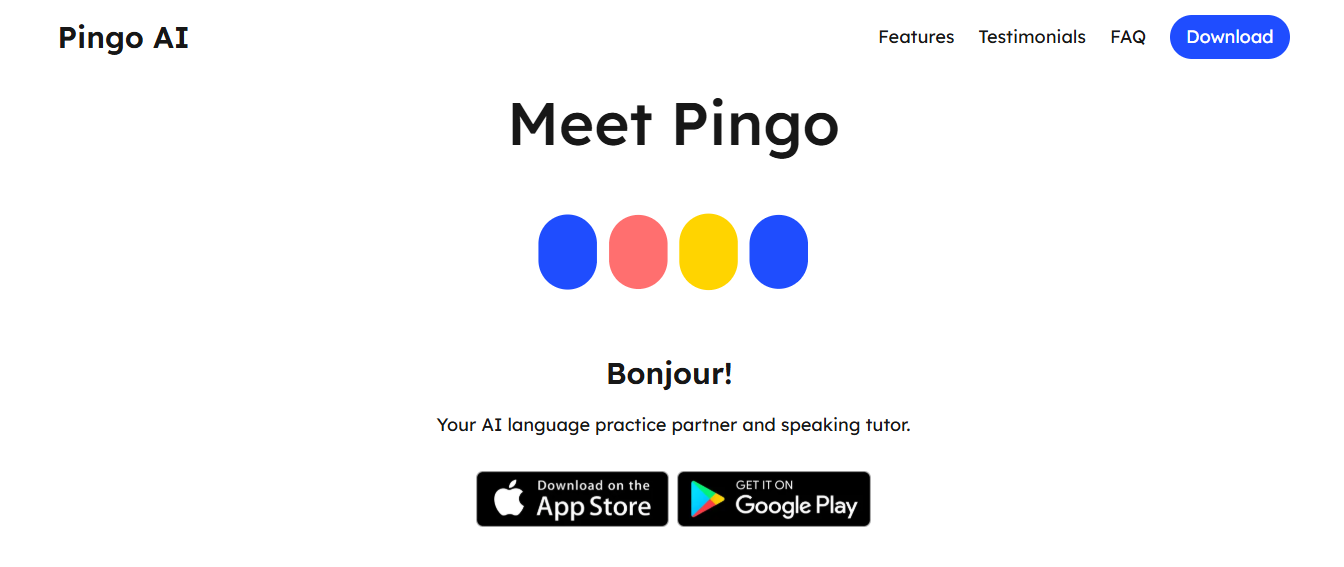Jumpspeak vs Duolingo (Which App Suits Your Learning Style?)

Michael Xing, Founder of Pingo AI
Picking the right app can mean the difference between memorizing phrases and actually speaking, which is why many learners compare Jumpspeak vs Duolingo when browsing top language learning apps. Jumpspeak focuses on conversational practice and pronunciation feedback, while Duolingo leans on bite-sized lessons, gamification, and steady vocabulary building. This article compares lesson format, adaptive learning, speech recognition, grammar drills, progress tracking, subscription cost, and free version features so you can pick the app that matches your learning style.
To help make that choice easier, Pingo AI offers an AI language-learning app that personalizes practice, provides clear pronunciation tips, and offers real conversation scenarios tied to your goals.
Summary
- Prioritizing speech over passive drills accelerates usable fluency, with speaking-first approaches reporting up to 50% faster learning than traditional methods.
Large-scale microlearning drives consistent habit formation, reflected in over 500 million registered users on major platforms, which explains why bite-sized practice suits casual or time-constrained learners. - Targeted, production-focused feedback produces measurable gains in confidence, with conversation-oriented users reporting a 70% increase in speaking confidence.
Active speaking practice yields stronger retention, with research showing production tasks are about 3.5x more effective for learning retention than watching or listening alone. - Business trends are shifting higher-value, interactive features behind paywalls, evidenced by a 46% jump in subscription revenue for a leading education platform in 2025, which can limit access to deeper speaking practice.
- Generous trials and unlimited access materially reduce churn risk for production-focused routines, as illustrated by 30-day unlimited trials that let learners validate speaking-first workflows before committing.
- This is where Pingo AI's AI language learning app fits in, by offering conversation-first roleplays and phrase-level feedback that align with practices shown to boost retention and speaking confidence.
Jumpspeak vs Duolingo at a Glance

Jumpspeak pushes you to speak from lesson one, training muscle memory and conversational instincts, while Duolingo scaffolds language across reading, writing, listening, and speaking in bite-sized, gamified steps. Your decision comes down to whether you want to accelerate real conversation now or build a broader foundation before you speak.
What Do Each Platform Prioritize?
Jumpspeak prioritizes active speaking, real-time correction, and scenario-driven roleplay that forces you to produce language under pressure. That orientation sharpens pronunciation, pacing, and the reflexes that let you answer quickly in real conversations. Duolingo prioritizes consistent, low-friction practice across many skills, using repetition, spaced review, and gamified streaks to keep beginners engaged.
Who Uses Each App, and Why Does That Matter?
Serious conversational learners and people who need speaking confidence quickly tend to choose speaking-first tools because practice mirrors real interaction and reduces anxiety.
Casual learners, complete beginners, and people who prefer micro-tasks at odd moments often pick broad-coverage apps for their convenience and habit-forming design. Duolingo has over 500 million registered users worldwide, which shows how large-scale reach suits generalist learners.
Does Prioritizing Speaking Actually Speed Progress?
That question matters because time is a scarce resource for most learners. Reported outcomes suggest it does, as shown by Jumpspeak users reporting a 50% faster language-learning experience compared to traditional methods, underscoring how front-loading spoken practice compresses the path to usable fluency rather than just passive recognition.
What Are the Tradeoffs You Should Weigh?
The tradeoff is depth versus breadth. Duolingo provides broad vocabulary and grammar exposure with high retention for recognition tasks, but it can leave people untested in spontaneous replies and under pressure on pronunciation.
Speaking-first approaches accelerate communicative competence yet sometimes require concurrent grammar study to avoid fossilizing mistakes.
Think of It Like Learning to Drive
Duolingo builds the car and the manual; Jumpspeak gets you onto the road and into traffic quickly, teaching you to handle real situations that textbooks cannot simulate.
How Should You Choose for Your Goals?
If you need to hold a conversation within weeks, prioritize a speaking-first routine and daily active practice that simulates fundamental interactions. If your goal is slow, comprehensive mastery of reading and writing, a structured, gamified program will better serve you. Either way, combine production with targeted review, and treat feedback as the engine of improvement rather than reward points or streaks.
Related Reading
- Babbel vs Duolingo
- How Much Is Duolingo Max
- How Much Does Babbel Cost
- Rosetta Stone vs Duolingo
- Best Apps to Learn Spanish
- Best Apps to Learn Japanese
- Busuu vs Duolingo
- Duolingo Alternatives
How Does Jumpspeak Work?

Building on the basics you already know, Jumpspeak runs like a live training loop. Short, structured practice feeds an always-on conversational engine that analyzes your speech, updates your learner model, and generates the next, slightly more complex challenge. The result is a continuous, production-focused practice that trades passive review for measurable speaking work.
How Does the AI Tailor Practice to My Mistakes?
This pattern appears across language apps, where static drills plateau because they do not track the right signals. Jumpspeak builds a rolling profile of three things:
- Pronunciation error clusters
- Response latency
- Lexical gaps
Those signals feed an adaptive scheduler that performs two actions in sequence:
- First, inserting micro-drills that isolate the problematic sounds or phrases.
- Then, reintroducing them in short, branched roleplays.
Hence, you practice under pressure, not in isolation. The branching keeps dialogs unpredictable, preventing the boredom that comes from identical scripts and forcing real-time retrieval.
What Kind of Feedback Does the System Actually Give?
Feedback is layered and actionable. You get immediate, phrase-level scoring so you know when to try again, plus a short post-session breakdown highlighting the top 3 errors, example corrections, and a one-minute drill you can run right away.
Jumpspeak’s reporting shows this approach builds confidence, with Jumpspeak users reporting a 70% increase in speaking confidence as of 2025, which aligns with how targeted cues convert halting phrases into fluent responses. That mix of in-the-moment correction and short, focused follow-ups is what makes mistakes worthwhile instead of demoralizing.
Why Does This Produce Stronger Memory Than Passive Practice?
Active production forces retrieval, and retrieval fixes memory. Studies from The National Training Laboratories in 2023 demonstrate that active speaking practice is 3.5x more effective in learning retention than watching videos/listening to audio, which explains why the app emphasizes output with spaced re-entry rather than longer passive sessions.
Practically, Jumpspeak interleaves short production tasks with spaced prompts so you revisit the same target forms in different contexts, reducing forgetting and building flexible recall.
What Breaks in Real Use, and How Does Jumpspeak Manage It?
The familiar approach is to rely on fixed lesson trees because they are easy to author, but that breaks down as learners need spontaneity and context sensitivity; repetition becomes rote, and motivation drops.
Jumpspeak mitigates that by generating varied conversational stakes, persona tones, and unscripted follow-ups, while keeping a safety net of constrained responses when the model’s confidence is low.
The Tradeoff is Clear
More variability raises engagement but demands stronger error handling, which is why the platform pairs generation with deterministic correction layers rather than raw freeform answers.
Pingo AI: Speak Fluently with Conversation-First Practice
Pingo's AI language-learning app focuses on conversation-first practice powered by expressive AI, offering real-world role-plays, precise feedback, and adaptive exercises that build fluent speech, not just recognition. Try Pingo free today and feel how natural speaking practice accelerates confidence and usable fluency.
How Does Duolingo Work?

Duolingo operates as a large-scale, adaptive microlearning engine that sequences short, repeatable exercises to keep learners returning and to strengthen recognition. Behind the friendly interface sit automated scoring, a decay-based scheduler that biases review toward recent errors, and speech detectors tuned for constrained answers rather than long-form conversation.
How Does Duolingo Choose What You Practice Next?
This pattern appears across adaptive systems. The platform builds a lightweight learner model from three signals, such as error frequency, time since last exposure, and completion behavior, then boosts items with high decay risk into your next session.
With 83 million monthly active users as of 2023, according to Analyzify, those signals must be compact and efficient, which is why Duolingo favors short exercises that are cheap to run at scale instead of long, bespoke speaking tasks.
Why Do the Energy Limits Interrupt Momentum?
When learners hit the in-app energy or heart cap in the middle of a lesson, the result is an abrupt stop, frustration, and often attrition. I’ve seen this pattern repeatedly: a user starts a focused 10- to 15-minute block, runs out of hearts, and loses the thread of practice.
Emotionally, it feels punishing, and that friction is what turns curiosity into hesitation. The lack of consistent options to restore energy compounds the problem, so many learners end sessions not because they are done, but because the system forces them to pause.
What Does Duolingo Actually Measure When You Speak?
Speech scoring works best for short, constrained prompts. The engine reliably flags pronunciation errors and gross mis-timings for single words or set phrases, but open-ended replies expose its limits in both accuracy and pedagogical usefulness.
In practice, that means learners get quick correctness signals, but not the layered, contextual feedback, prosody, pragmatic fit, and pacing that converts halting answers into fluent responses.
Where Does the Product Design Trade-Off Scale for Depth?
Most teams design micro-lessons because they are low-cost to author and simple to scale, and that makes sense at Duolingo’s reach. The hidden cost is that as exercises stay isolated, learners accumulate recognition without robust production practice, and the transfer to live speaking weakens.
Platforms like Pingo AI show an alternative. Always-available roleplays across hundreds of scenarios, phrase-level feedback, and session transcripts that preserve continuity, so learners can sustain practice without being yanked out by an energy cap.
How Is Business Strategy Shaping Feature Focus?
The market has shifted toward monetizing personalized, AI-driven experiences, and that shows up in product roadmaps. Duolingo’s push into AI content helped subscription revenue increase 46% in 2025, according to EdTech Innovation Hub, which explains why more interactive, high-value features are moving behind paywalls. For learners, this can mean better content, but also more gated access to the very practices that reduce real-world speaking anxiety.
What Breaks as Learners Scale Up Their Goals?
Micro-drills work when your aim is vocabulary recall and a daily habit. As soon as the goal shifts to fluent, spontaneous speech, the friction points multiply because error correction requires timing, context, and repeated role-play under pressure.
That’s why some learners describe the app as perfect for small rehearsals, but insufficient for carrying on a conversation in the real world; it’s like training with flashcards when the test is an interview.
Related Reading
- Memrise vs Duolingo
- Best Apps to Learn French
- Lingodeer vs Duolingo
- Pimsleur vs Babbel
- Best Apps to Learn Mandarin
- Best Apps to Learn Arabic
- Best Apps for Learning English
- Best Russian Learning Apps
Jumpspeak vs Duolingo: Key Feature Comparison

Both platforms offer polished experiences, but the choice comes down to what operationally matters for your learning goals. Pick the one whose tooling matches how you will practice, measure, and scale.
Below is a map of feature-level differences that matter when you move beyond lesson lists and into real-world use, such as speech engine precision, long-form conversation handling, educator integration, analytics depth, accessibility, and pricing mechanics.
How Precise Is Their Speech Tech Under Realistic Conditions?
Duolingo runs fast, lightweight checks that work well for short prompts and high-volume use, keeping latency low on older devices. Jumpspeak and similar conversation-first tools invest more in phoneme-level scoring, prosody analysis, and multi-turn coherence, which increases processing load but gives feedback you can act on within a single session.
Practically, that means one product tells you if an answer is close enough, the other tells you which exact syllable or timing to fix so your following sentence sounds natural.
How Do They Handle Long-Form, Unscripted Replies?
Some engines collapse once utterances exceed a few seconds; error rates climb, and feedback becomes noisy. Platforms that support sustained dialogue apply chunking, incremental scoring, and deferred post-session diagnostics so a five-minute roleplay does not generate dozens of false positives.
If you care about flowing answers rather than isolated phrases, look for transcript exports, sentence boundary detection, and a scoring timeline that marks where your fluency dipped, not just whether you passed a prompt.
How Well Do They Work for Teachers, Tutors, and Classrooms?
Most classroom workflows start with assigning content and tracking mastery, but not all apps make it easy to export evidence. The ones built for instruction provide CSV exports of session transcripts, shared class dashboards, and LTI or API hooks so tutors can pull student audio into their grading workflow.
If you plan to blend human coaching with AI practice, prioritize platforms that let teachers annotate sessions, push targeted drills to individual learners, and synchronize progress with external LMS tools.
What Kind of Learner Data and Reports Do They Provide?
Some apps surface only high-level badges and streak counts. Better tools deliver layered reports, such as cumulative speaking minutes, average response latency, top recurring phoneme errors, and a short list of targeted drills to run next.
Those metrics let you change practice strategy mid-course, for example, switching a learner from vocabulary review to prosody drills when fluency plateaus. If the report is a black box, your next practice session will be guesswork.
How Do Accessibility, Offline Use, and Language Breadth Compare?
If you travel or study in low-connectivity settings, offline audio processing and downloadable lesson packs matter. Some consumer apps support offline lessons but sacrifice speech-scoring accuracy when running on-device.
Also check dialect and accent coverage, plus accessibility features such as adjustable font sizes, dyslexia-friendly layouts, and alternative input modes for users who type instead of speak. These details determine whether a platform is usable in real daily contexts or only in ideal conditions.
What Do Their Pricing and Trial Terms Tell You About Risk?
Free tiers and short trials lower the barrier to try an app, but the structure matters for deep practice. If you want to commit time to systems that analyze and personalize multi-week progress, a generous trial reduces churn risk. For example, Jumpspeak offers a 30-day free trial with unlimited access to all features, which gives learners space to test production-focused routines without immediate paywalls.
On the other side, scale and community size shape content variety and peer support, as reflected in Duolingo, which has over 500 million registered users worldwide, a reach that drives rapid content testing and broad language offerings.
What Should Product-Minded Learners Inspect Before Deciding?
Treat the app like a toolset, not a logo. Check whether it logs practice artifacts you can revisit, whether drill recommendations are evidence-based rather than random, and whether you can route problem sounds into repeatable micro-exercises.
Also, verify privacy and export controls if you plan to share recordings with tutors. The right platform reduces overhead, so you spend time speaking, not stitching together workarounds.
Pingo AI: Speak Fluently with Conversation-First Practice
Pingo's AI language-learning app focuses on conversation-first practice powered by expressive AI, offering realistic role-plays, phrase-level feedback, and adaptive exercises that build fluent speech, not just recognition. Try Pingo free today and experience how everyday speaking practice turns hesitation into confidence.
Which Language Learning App Should You Choose?

Pick the app that solves the single most significant constraint holding you back:
- If your barrier is inconsistent time and habit, pick a high-frequency micropractice tool
- If your barrier is nerves and real-life speaking, like a conversation-first system that forces you to speak under pressure
- If you want tutor-grade, repeatable conversation drills with transcriptable feedback, choose a platform that simulates fundamental interactions and gives precise corrections.
This decision is about the constraint you want to fix, not the logo you like.
How Much Time Can You Actually Commit Each Day?
If you reliably have under 10 minutes, you need tiny, repeatable lessons that reward consistency. If you can do 10 to 30 focused minutes, prioritize sessions that require you to produce language aloud and recover from mistakes.
If you can invest 30 to 60 minutes several times a week, treat practice like deliberate rehearsal, combining targeted feedback with varied roleplays. For scale, remember that Duolingo reaches over 50 million learners monthly as of 2025, which is why it works well for short, habit-based practice. Over 50 million people use Duolingo to learn a new language every month..
What Outcome Matters Most This Month, Not Someday?
If your immediate need is to show up in a conversation that goes smoothly, prioritize a system built around spoken retrieval and error correction. If you are prepping for a written exam or want broad literacy first, prioritize comprehensive drills and spaced review.
When we coached a mixed group of learners over six weeks, the pattern was clear. Those who scheduled short, high-pressure speaking drills reduced their hesitation in live practice more quickly than those who only logged recognition exercises, even when total minutes were similar.
Which Risks Are You Willing to Tolerate: Fossilized Errors or Slow Progress?
Production-heavy routines speed conversational readiness but require ongoing corrective loops to avoid cementing mistakes. Recognition-heavy routines reduce early errors in controlled tasks but leave gaps when you must produce language spontaneously. If you want to avoid that trap, pick an approach that pairs immediate corrective feedback with spaced re-entry so errors are corrected before they fossilize, not after.
Are the Speed Claims Realistic for Your Schedule?
If a vendor promises conversational outcomes in weeks, check the delivery conditions, such as the frequency of active speaking, the intensity of feedback, and whether drills are embedded in unpredictable role-plays.
For example, some products advertise rapid gains, with claims like Babbel users can achieve conversational proficiency in as little as 3 weeks, but that assumes daily, focused speaking and guided correction, not passive review. PCMag, Babbel users can achieve conversational proficiency in as little as 3 weeks. Match promised timelines to your real calendar before you commit.
Practical Selection Checklist
- If you need a daily habit and low friction, prioritize platforms that make streaks painless.
- If you need immediate speaking performance under stress, choose systems that force retrieval in unpredictable scenarios.
- If you want coach-ready records and repeatable drills, choose apps that export transcripts, tag recurring phoneme errors, and let you replay problem spots.
Start Learning A Language with Pingo for Free Today

It’s exhausting when lessons stack up, but you still freeze in honest conversations, so if you want practice that actually moves the needle, consider Pingo, with over 1 million downloads, showing many learners have already tried it. I trust outcomes you can feel, and 90% of users report improved speaking skills within 3 months. Try the free tier and let small, regular conversations build absolute confidence.
Related Reading
- Best Apps for Learning Korean
- Best Apps for Learning Spanish
- Best Apps for Learning Portuguese
- Best Apps for Learning Spanish
- Best Apps for Learning Russian
- Best Apps for Learning Italian
- Best Apps for Learning German
- Best Apps for Learning English
- Best Russian Learning Apps